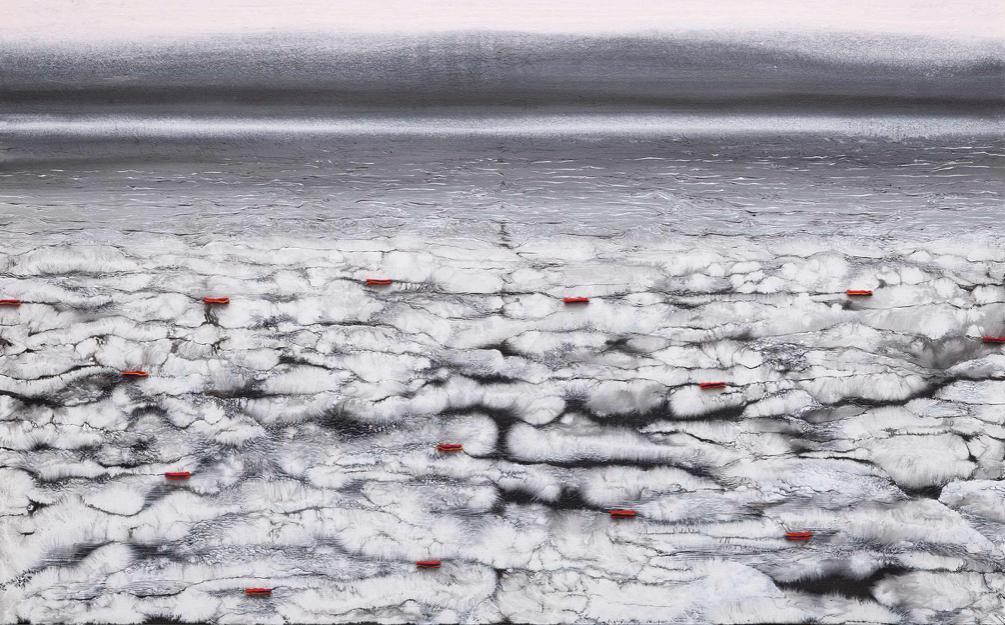Rádje johtin I (Pacing the Borders I). Outi Pieski. 2014. Acrylic on canvas, wool and metal wire. 76 x 122 cm. RiddoDuottarMuseat. SD 733. Photo: Håkon Holmgren Gabrielsen
In Rádje johtin I (Pacing the Borders I), Outi Pieski (born 1973 in Helsinki, based in Ohcejohka (Utsjoki), Finland) juxtaposes acrylic paint and tassels (diehpit) made of baize – a coarse, feltlike, woollen fabric – on canvas, mounted on board. This combined work is part of a series of five. Their common motif hint at landscapes covered in snow and ice, with traces of vegetation, rivers or lakes, hills or mountains, distant horizons, and skies. If so, what are the tassels doing there? Why are they so conspicuously coloured in deep red, yellow and blue?
In Rádje johtin I, the paint was applied with a wet-on-wet technique, leaving visible traces of the process and partial blending of the colours. In the upper half, stark contrasts between dark and light produce an atmosphere of mystique. In the lower half, fourteen tassels were fastened, each with a metal wire which runs inside the baize, through the canvas and the board to the back where it is twinned. They act as decorative contrasts to the painted surface, and as energetic forces of movement. Are they also signs?
In the centre, a dotted, vertical line divides most of the composition. Might that be a border? If so, what kind of border? There is also another divide at work here. The lower half of the image confronts us almost like a wall due to its brushwork, its pattern of infiltrated colours, and the protruding tassels. In the above, the brushwork gradually changes into even, horizontal bands which enhance an impression of receding, vast expanses.
How do the tactile effects of Rádje johtin I underline its qualities as an object? Pieski explains that she was inspired by the Sámi reindeer calf fur hat for women, miessenáhgahpir. When mounting the pieces of calfskin, tassels of baize are fastened so that they strengthen the seams of the gahpir. Rádje johtin 1 is, then, also a comment on duodji. The duojár, the practitioner of duodji, contributes to shared knowledge and practices of Sámi material-, aesthetic-, and intellectual culture.
It is tempting to compare Pieski’s Rádje johtin I with Johan Turi’s “Spring Migration”. Both activate inhabited landscapes and implied symbolic regimes. They ask us to acknowledge the land of Sápmi. But borders are intervening. Turi responds by representing the herders and their animals in cooperation, protected by spiritual powers. According to Outi Pieski, the miessenáhgahpir ‘bring[s] out the femininity in the land.’ In Rádje johtin I, then, each miessenáhgahpir protects against the cold, the wind, and the snow in direct and metaphoric ways. This might be understood as how and why Rádje johtin I crosses several borders in activating feminine forces of revitalization and decolonization of Sápmi.
Essay by Svein Aamold
Further reading: See Pieski’s home page for images of the complete series of Rádje johtin, www.outipieski.com/paintings/
